Editor’s note: This essay by David Pullins is a pendant to Damiët Schneeweisz’s Laboring Likeness: Charlotte Daniel Martner’s Paint Box in Martinique (1803-1821). Together, Pullins and Schneeweisz unpack two paint boxes that belonged to Marie Victoire Lemoine (1754-1820) and Charlotte Daniel Martner (1781-1839), bringing out how these boxes tie the material history of painting to gender, colonialism, and enslavement.
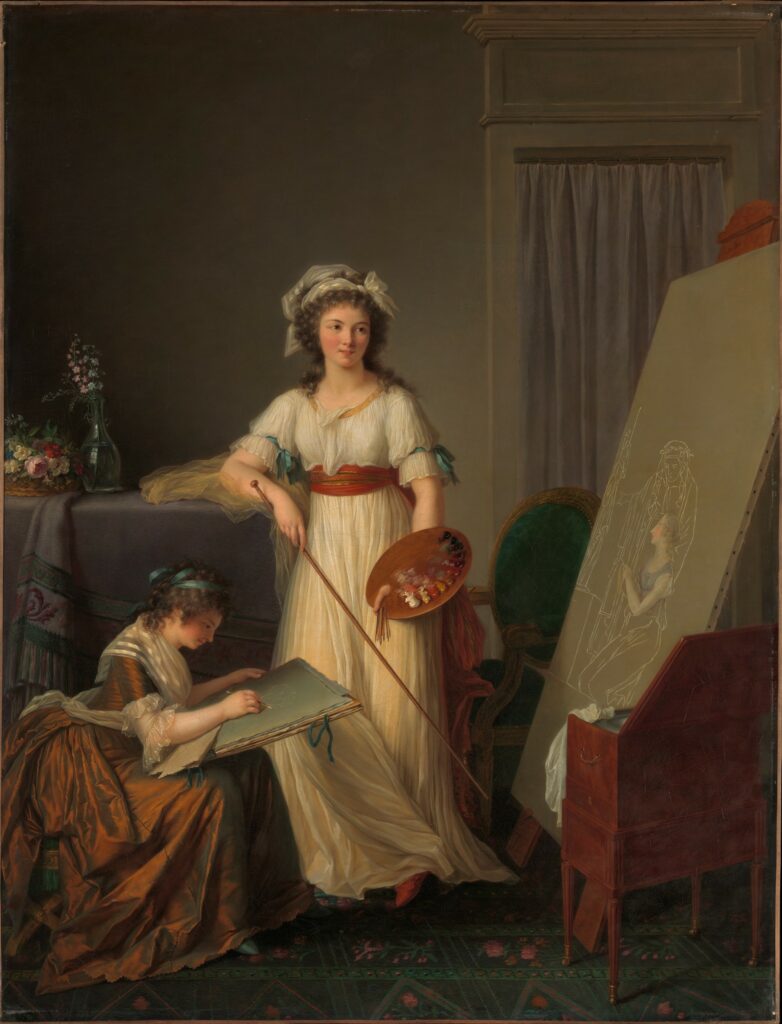
Holding a loaded palette, brushes and maulstick, a standing woman represents the art of painting, while a second woman seated on a low stool embodies the foundational art of drawing (Fig. 1).[1] Their practices converge in the canvas underway on an easel, depicting a priestess presenting a young woman to a statue of Athena, goddess-protectress of the arts, in which chalk outlines have begun to be fleshed out in color. But the allegory has been dressed in contemporary terms, pointedly situating Marie Victoire Lemoine’s The Interior of a Woman Painter’s Atelier in the year it was executed, 1789, and boldly taking on the language of genre painting that was used more often to critique than to promote women artists. Michel Garnier’s A Young Woman Painter from the same year offers a counter-image (Fig. 2). A painter sets her canvases aside (literally turned to the wall, her easel reflected distantly in the mirror), while she is distracted by love (signaled by the dove, flowers, and book propped on an insubstantial table easel). In contrast to Lemoine’s somber, antique mise-en-abyme, Garnier chooses an unfinished “Greuze girl” as his gloss.
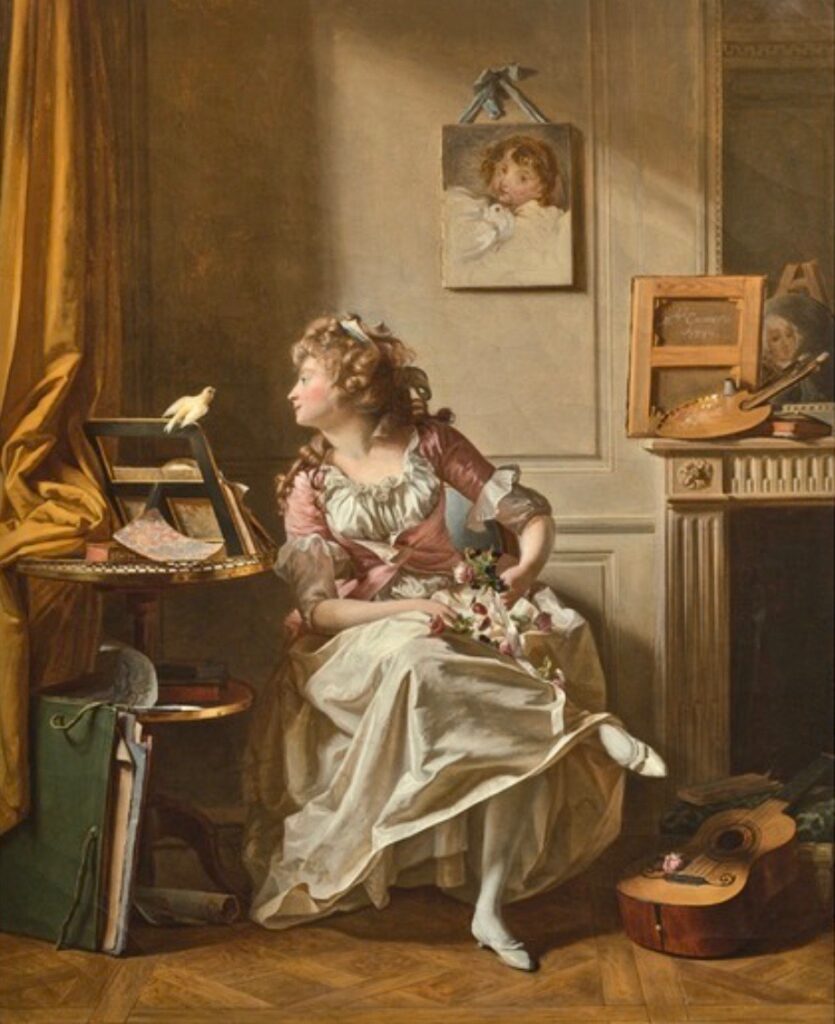
Among the most prominent objects in The Interior of a Woman Painter’s Atelier is Lemoine’s own mahogany-veneered paint box, which in 2023 joined the painting itself at The Metropolitan Museum of Art (Fig. 3).[2] Its integration into our understanding of this watershed moment in the public visibility of women artists in France and the professionalization of painters more broadly is compelling on at least two fronts: first, as an object of self-fashioning used in the actual production of Lemoine’s work, and second, as an object of representation chosen for inclusion in Lemoine’s idealized vision of her profession.
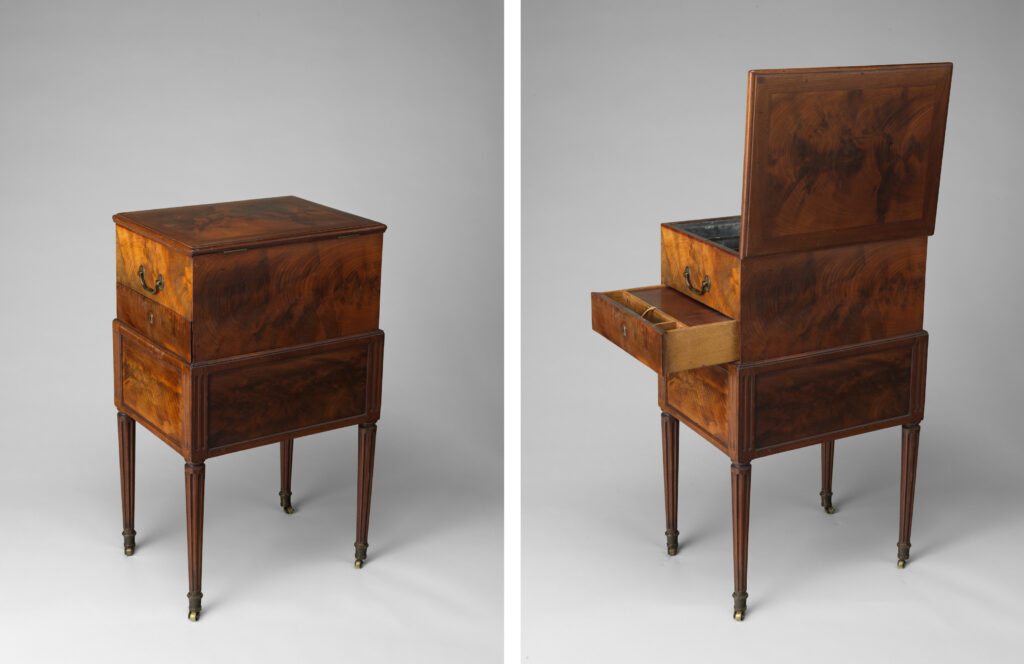
The paint box has a hinged lid, an interior with two tiers of zinc compartments and a lockable drawer with three compartments, one of which has a protective wood cover. Two cylindrical brass boxes are all that remain of its contents. Brass handles allow the box to be lifted from its stand, which consists of two drawers on four fluted legs resting on brass casters that slide easily across the floor. The stamp of the cabinet-maker (ébéniste) Caspar Schneider is burnt into the top edge of one of the box’s side panels.[3] Born in Augsburg, Germany, Schneider arrived in Paris in 1768 and worked with Martin Carlin, a cabinet-maker famous for innovative furniture forms, many incorporating Sèvres porcelain plaques. Within a year of Carlin’s death, Schneider married his widow, Marie-Catherine, of the Oeben furniture-making dynasty. Thus situated, he became a guild master on March 15, 1786, and the Lemoine paint box’s jurande punch, or guild mark, confirms that it was made after this date. Carlin’s impressive clientele, including Marie-Antoinette and Louis XV’s daughters, continued to patronize Schneider until the French Revolution, indicating this object’s prestige.[4]
Lemoine’s paint box most likely dates from 1789, the year not only of The Interior of a Woman Painter’s Atelier, but also of a key moment in the artist’s domestic situation, when she moved into an apartment in the rue Richelieu with her younger sister, Marie Élisabeth Gabiou, and her brother-in-law, Jean-Frédéric Gabiou. The paint box’s absence from inventories taken in this otherwise well-documented period indicates that it likely arrived precisely as their households were integrated.[5] Other paintings suggest that this is not the only object in The Interior of a Woman Painter’s Atelier based on their apartment’s actual furnishings. Marie Élisabeth’s later Self-Portrait includes the paint box and the same green upholstered, oval-back chair (Fig. 4), while Marie Victoire’s portrait of Marie Élisabeth’s son, Henri Gabiou (1791; private collection), depicts a green upholstered stool, presumably from the same suite of furniture, and a similar floral carpet.[6] These works evoke a space with overlapping domestic and artistic functions, one in which the paint box announced a particular social position and degree of professional achievement.
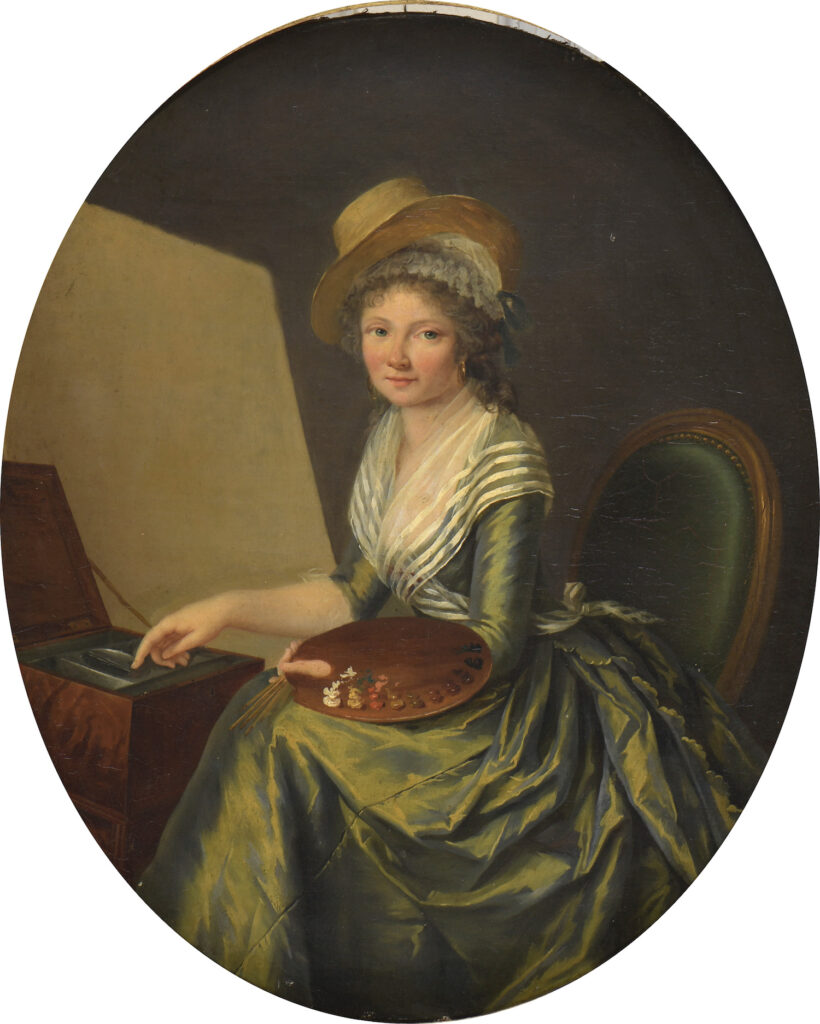
While a Schneider paint box was not entirely out of the Lemoines’ financial reach, it may have come as a gift, an additional reason to foreground it in her painting. Among Marie Victoire’s sitters are numerous possible candidates.[7] Moreover, the prominent académicienne Elisabeth Vigée Le Brun, who has often been identified without conclusive evidence as the standing figure in Lemoine’s painting, occupied adjacent professional circles through Lemoine’s teacher, François-Guillaume Ménageot.[8] Finally, Gabiou’s role as notary to the Genlis family brought him into regular contact with wealthy Parisians. His circles also help draw out an underlying socio-economic aspect of Lemoine’s paint box. Carlin and Schneider followed rising French fashion for mahogany that flowered in the late 1780s. This was part of a wider Anglophilia given that Londoners had widely adopted mahogany furniture by the 1740s. Like the fashion for white cotton dresses, it was also materially and economically inextricable from the colonization and exploitation of the Americas. In fact, the advent of mahogany in Paris was anticipated by its use in so-called port furniture, produced in La Rochelle, Bordeaux, Nantes, and Saint Malo, where fortunes were being made through trade in mahogany, sugar, and enslaved Africans. In effect, these cities imported a taste that flourished in the French Caribbean and kept the tinge of colonial society as it moved from periphery to center.[9]
Without suggesting any stake deliberately claimed by Lemoine or her family in colonialism through this object, its mahogany veneer does announce the imbrication of Parisian society in a global network of colonialism and slavery, or what Simon Gikandi describes as mutually defining terms of slavery and cultures of taste.[10] Marie Élisabeth’s Self-Portrait (see Fig. 4) underscores these subtle connections with hooped-earrings, a fashion known as “à la creole,” ultimately inspired by Caribbean dress popularized as “plantation fashion” with madras headscarves in 1790s Paris.[11] At the moment Lemoine joined her sister and Jean-Frédéric Gabiou in the rue Richelieu, their social and professional ties were, in fact, drawn closely to Paris’s colonial conquests: during this period, Gabiou’s principal patrons, the Genlis, raised a niece born in Saint-Domingue, and Gabiou served as the notary for real estate speculation and after-death inventories among a significant group of pro-slavery voices and owners of hundreds of enslaved Africans across the Caribbean.[12]
For visitors to the rue Richelieu—or, for Lemoine’s elite sitters, if she brought this portable object to their homes—the mahogany paint box therefore announced social and economic privilege. Still further meanings were implied by its representation on canvas, particularly as a survey of artists’ portraits and self-portraits reveals that independent, purpose-made paint boxes are surprisingly unusual in eighteenth-century French art. By the 1780s, self-portraits and the many portraits of fellow artists required as reception pieces to the Académie royale had established a well-worn iconography: a loaded palette and brush or, to underscore the masculine primacy of drawing, the porte-crayon, typically with its marks left outlining a composition.[13] Makeshift, waist-high approximations of paint boxes, often with an open drawer revealing a cloth, were frequently included.
As Hannah Williams notes, however, it was only with artists’ increased use of full-length formats in the last quarter of the century that it was possible to depict purpose-made paint boxes such as Lemoine’s, even if variations on them had long been in use.[14] At a very basic level, this implies a relationship to capturing a fuller image of the artist at work, one that transposes attention to tools and context as much as it does to the painter’s body. Bonaventure-Louis Prévost’s didactic composition depicting an atelier for the Encyclopédie plates, printed in 1765, zooms out sufficiently to afford a view of two improvised paint boxes atop chests, but foregrounds a luxurious paint box with two drawers and cabriole legs used by a history painter who works at such an ambitious scale as to require a ladder. At left, a woman seated on a low stool paints a portrait with the aid of a makeshift box.
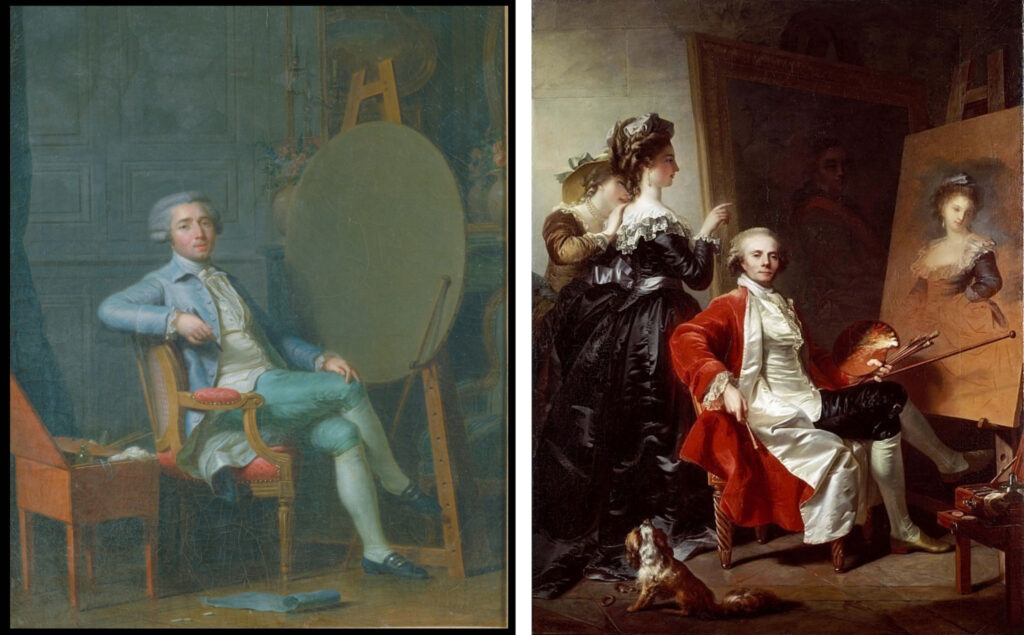
The closest precedent to Lemoine’s image appears to be a full-length self-portrait by the little-known artist Jean-François Lassave that he submitted, in 1787, as his reception piece to the Académie royale de peinture, sculpture et architecture de Toulouse (Fig. 5, left).[15] Like Lemoine’s composition, the footed paint box works with the well-appointed interior and his own fashionable dress to alert us to financial stability and success, while also signaling a seriousness of purpose. Lemoine is unlikely to have seen Lassave’s self-portrait, but she certainly knew Adélaïde Labille-Guiard’s celebrated self-portrait with pupils shown at the Paris Salon of 1785, in which a similar, open paint box is tucked discretely into the background. The most imposing male portrait or self-portrait to include a footed paint box of this kind is Jean-Laurent Mosnier’s Self-Portrait with His Daughters (1787; Fig. 5, right), directly modeled on Labille-Guiard’s composition, even if he reinscribes her vision of female teachers and students within a patriarchal hierarchy.[16]
Early in her career, Lemoine executed an Allegory of Painting (1777; Musée des beaux-arts, Orléans), which so solidly abstracts the idea of a female artist as to denude it of any punch: even when read as a kind of self-portrait (as such images inevitably are when women paint them), she ultimately blends into a type painted by many men before her. In The Interior of a Woman Painter’s Atelier, however, Lemoine devised an image that reads primarily from its contemporary context, underneath which, at a second degree, an allegorical structure organizes the arts of painting and drawing combined on an easel depicting virtuous women in the guise of classical history. The prominence of Lemoine’s own paint box attests clearly to the lived nature of this image, situating it in the here and now—so much so that table and painting most likely date to the same year. Countering images such as Garnier’s trivializing depiction, this furniture aides her cause, assertively but with calculated restraint. Her paint box perfectly encapsulates the painting’s careful balance: not a make-shift object, this is an elegant, purpose-built tool that literally contains the messy activity of the workshop, while figuratively containing women’s artistic practice within economies and networks that were both domestic and global.
David Pullins is Associate Curator in the Department of European Paintings at The Metropolitan Museum of Art
I am very grateful Catherine Girard, Meredith Martin, and Hannah Williams of Journal18 for their invitation to think through Lemoine’s paint box in tandem with Damiët Schneeweisz, whose insight on both this object and Martner’s paint box have greatly informed my own. Additional thanks to Katrin Bellinger, Daniëlle kisluk-Grosheide, Anita Sganzerla, Perrin Stein, and Stephan Wolohojian.
[1] This title is taken from the Salon of 1796, where this painting was most likely exhibited by Lemoine as no. 284 under the title “L’intérieur d’un attelier [sic] de femme, peintre.” On the painting and Lemoine see, in particular, Joseph Baillio, “Vie et oeuvre de Marie Victoire Lemoine (1754-1820),” Gazette des beaux-arts 127 (April 1996), 125-64; Katharine Baetjer, French Paintings in The Metropolitan Museum of Art from the Early Eighteenth Century through the Revolution (New Haven: Yale University Press, 2019), 347–50; Paris A. Spies-Gans, A Revolution on Canvas: The Rise of Women Artists in London and Paris, 1760-1830 (New Haven: Yale University Press, 2022), 81, 191; Carole Blumenfeld, “Je declare vivre de mon art”: Dans l’atelier de Marie Victoire Lemoine, Marie Elisabeth Lemoine, Jeanne Elisabeth Chaudet, Marie Denise Villers, exh. cat., Musée Fragonard(Grasse: Montreuil, 2023). For a complete bibliography, exhibition and provenance history see The Met’s online entry (all web links accessed October 2023).
[2] Sold with other works descended through the Lemoine family, De Baecque et Associés, March 27, 2019.
[3] For Schneider, see Alexandre Pradère, French Furniture Makers: The Art of the Ébéniste from Louis XIV to the Revolution, trans. Perran Wood (Malibu, CA: The J. Paul Getty Museum, 1989), 419.
[4] A bureau plat with inset Japanese lacquer panels supplied to Madame Adélaíde is stamped by both Carlin and Schneider and dated ca. 1784 (Musée du Louvre); Schneider’s most prestigious independent commission was a guéridon for Marie-Antoinette dated 1786 (Musée des châteaux de Versailles et de Trianon).
[5] Archival documentation is deeply indebted to the recent work of Blumenfeld, “Je déclare,” 32-5, 168-9.
[6] Blumenfeld, “Je déclare,” 35, 41.
[7] Baillio, “Vie et oeuvre de Marie Victoire Lemoine,” 145-6; Blumenfeld, “Je déclare,” 104-5, 112-3.
[8] Vigée Le Brun’s identification has been argued most influentially in Baillio, “Vie et oeuvre de Marie Victoire Lemoine,” 134-6. On Ménageot, see Blumenfeld, “Je déclare,” 16-7.
[9] See Jacqueline Viaux-Locquin, Les bois d’ébénisterie dans le moblier français (Paris: Libraire Léonce Laget, 1997), 2-10; Chaela Pastore, “Mahogany as Status Symbol: Race and Luxury in Saint Domingue at the End of the Eighteenth Century,” in Furnishing the Eighteenth Century: What Furniture Can Tell Us About the European and American Past, ed. Dena Goodman and Kathryn Norberg (Milton Park, UK: Routledge, 2007), 37-47; Madeleine Dobie, Trading Places: Colonialization and Slavery in Eighteenth-Century French Culture (Ithaca & London: Cornell University Press, 2010), esp. 63-72.
[10] Simon Gikandi, Slavery and the Culture of Taste (Princeton: Princeton University Press, 2011).
[11] Amelia Rauser, The Age of Undress: Art, Fashion, and the Classical Ideal in the 1790s (New Haven & London: Yale University Press, 2020), 140.
[12] Blumenfeld, “Je déclare,” 37, 44. During the 1780s, Madame de Genlis raised her niece, Rose Henriette Péronne de Sercey, who had been born in Torbeck, Saint Domnigue, in 1772. My thanks to Meredith Martin for observing this further connection.
[13] See Hannah Williams, Académie Royale: A History in Portraits (Farnham, UK: Ashgate, 2015).
[14] Conversation with Hannah Williams, September 9, 2023. An early exception proving the rule is Charles-Antoine Coypel’s Self-Portrait (1746; Musée des châteaux de Versailles et de Trianon), which includes a hinged lid opened to reveal compartments like Lemoine’s paint box. On the objects themselves and re-thinking their relationship to their owners, see Katie Scott and Hannah Williams, Artists’ Things: Discovering Lost Property from Eighteenth-Century France (Los Angeles: Getty Research Institute, 2024), 79-86, 243-50.
[15] See their online entry: https://www.augustins.org/fr/notice/2004-1-242-autoportrait-52e64a70-6741-412e-ace1-8f7267f0a1b9.
[16] Laura Auricchio, Adélaïde Labille-Guiard: Artist of the Age of Revolution (Los Angeles: The J. Paul Getty Museum, 2009), 40-4.
Cite this note as: David Pullins, “Contained Assertions: Marie Victoire Lemoine’s Paint Box,” Journal18 (December 2023), https://www.journal18.org/7149.
License: CC BY-NC
Journal18 is published under a Creative Commons CC BY-NC International 4.0 license. Use of any content published in Journal18 must be for non-commercial purposes and appropriate credit must be given to the author of the content. Details for appropriate citation appear above.

Pingback: Laboring Likeness: Charlotte Daniel Martner’s Paint Box in Martinique (1803-1821) – by Damiët Schneeweisz – Journal18: a journal of eighteenth-century art and culture